2016
Soybean Planting Date
NDSU’s general soybean planting date recommendation is the first half of May when soil temperatures are consistently 50 degrees F or higher. Very early planted soybean in cold (and wet) soils may result in reduced seed germination (due to imbibitional chilling), increased risk of seedling disease and ultimately poor field stands. Emerged soybean plants are susceptible to air temperatures at 30 degrees and less. Also, the earliest insurance plant date for North Dakota is May 1. With the high possibility of an early spring and early planting season, farmers may have the opportunity to plant soybean earlier than normal.
NDSU conducted eight soybean planting date trials during 2011 through 2015 at Carrington, Hettinger, New Rockford, Prosper and Wishek (see graph below). The ‘early’ planting dates ranged from April 24 to May 5 and the ‘normal’ planting dates ranged from May 15 to 23. Soil tilth was appropriate with the early planting though soil temperatures at and following planting often were less than 50 degrees. Five of eight trials had a statistically significant (LSD 0.05 = *) yield advantage with early vs. late planting. Averaged across trials, early planted soybean yield was 9% or 3.9 bu/acre greater than with normal planting dates. Range of yield advantage with early planting among trials was -5.3 to 8.4 bu/acre.
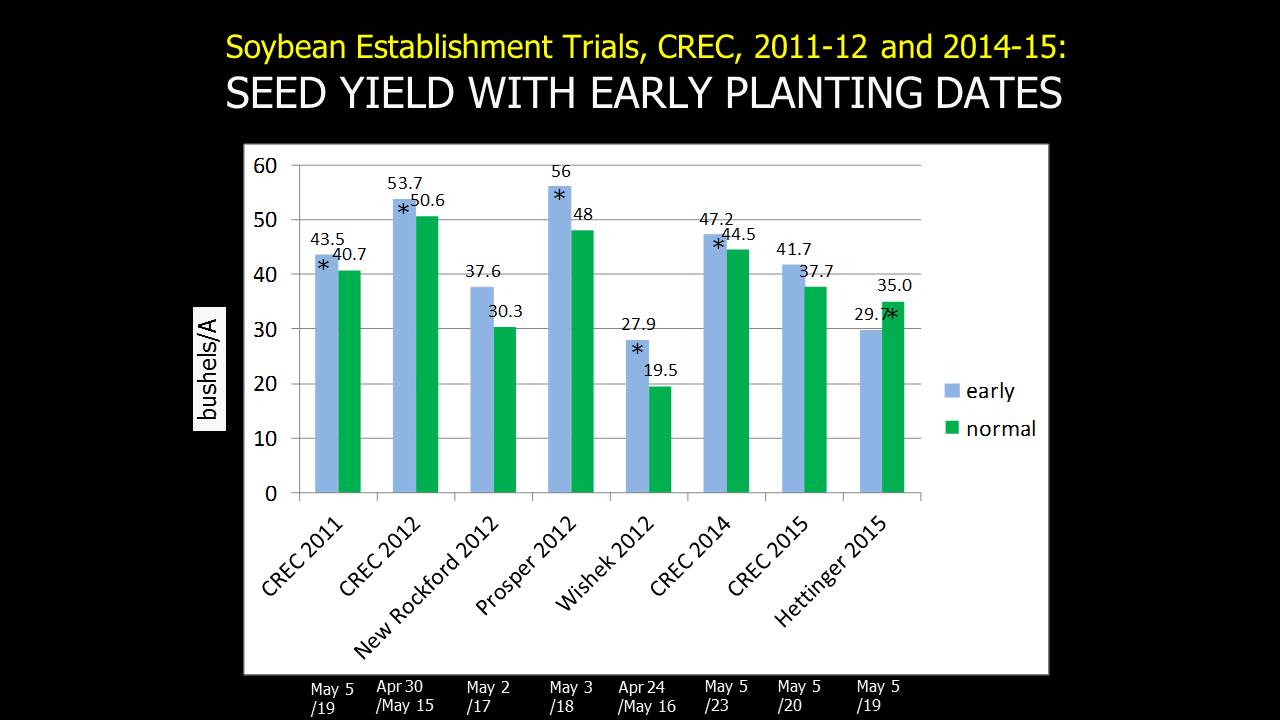
Reasons for yield increase with early planting soybean include opportunity to use later-maturing varieties (generally with greater yield potential) and quicker canopy closure (advantages of capturing more sunlight, conserving soil moisture and increasing competition with weeds). Fungicide seed treatment is recommended if planting early.
In summary, though risks are involved with earlier than normal planting dates, the data indicates potential for higher soybean yield with no additional cost for early planting.
Greg Endres
Area Extension Agronomist
Growing Grasses and Legumes Together
One possible method to reduce nitrogen requirements is to grow a legume in combination with a grass, otherwise referred to as multiple cropping. These two plant types grow well together and can complement each other in forage and other production systems.
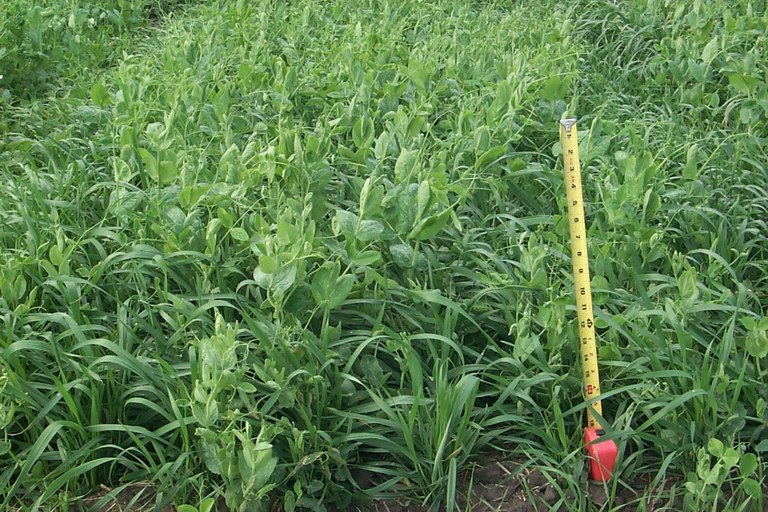
Triticale and pea in early vegetative stage at the CREC.
Field trials were conducted at the CREC during the 2008-2011 growing seasons to compare multiple cropping of cereal/pea forage to monocultures of cereal and forage pea. Spring cereals used in these trials were barley, oats, and triticale. Varieties of oats and triticale used varied throughout the years of study. Varieties used in the trials were: Arvika forage pea, Haybet forage barley, Morton or Paul grain oats, TriCal 2700 or 141 forage triticale. The trials were planted in early May of each year in fields that tested low (average 30 lb. /ac) in available nitrogen. No additional fertilizer was used to grow the forage treatments. Cultural methods including tillage, seeding date and rate were used for weed control, with no herbicides used. Seeding rates used were 1 million pure live seeds/ac for the monoculture cereal treatments, with the sole forage pea sown at 300,000 PLS/ac. When grown in mixtures the cereals were sown at 800,000 PLS/ac and forage peas at 200,000 PLS/ac. All pea treatments were inoculated with rhizobia to aid in N fixation. Forage treatments harvest dates were determined by the growth stage of the forage. Triticale was harvested first when the plant was in the anthesis stage, followed by the barley which was harvested in the soft dough stage, and oats in the early milk stage. Forage peas were harvested approximately 7 days after flowering.
Data gathered (table 1) from these trials indicate that growing cereals in combination with peas will have a positive impact on both yield and quality in forage production. Adding peas to any one of the spring cereals increased yield when compared to the sole planting of the cereal forage. Forage quality was also impacted by the addition of peas to the cereal forage crops. Crude protein of the cereal/pea mixes were raised on the average by 3% or more when compared to the sole cereal treatments. Overall, the greatest impact from adding peas to cereals appears to be on forage quality when compared to cereals planted alone, indicating multiple cropping with peas may contribute to the overall soil N bank.
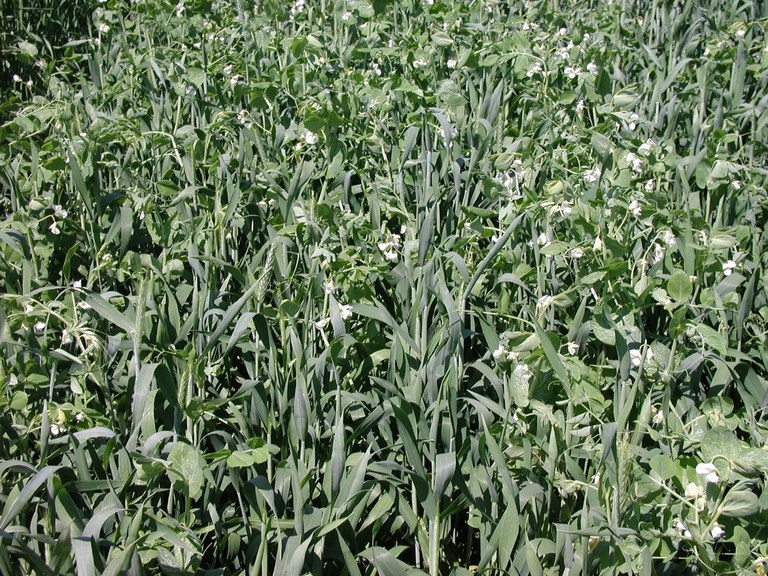
Triticale in late boot stage with peas blooming.
Steve Zwinger
Agronomy Research Specialist
Does strategic tillage help minimize the impact of phosphorus stratification on crop yields in no-till farming?
Some farmers wonder if strategic tillage, i.e., occasional tillage (for example every 10 years), of their long-term no-till (NT) field to manage some undesirable impact is necessary.
What impact does one-time tillage after a long period of no-till have on my soil and yields? These concerns were raised due to stratification of P (accumulation near soil surface) within the top soil and in some cases pH, weed prevalence, and soil compaction.
Nutrient stratification: Due to placement and very low mobility in soil, nutrients like P, K, and Zn accumulate in the top 3 or 4 inches of soil in long-term NT. When the topsoil is very dry, stratification can lead to low P uptake. But positive yield responses to the practice of a one-time tillage strategy for long-term NT fields have been inconsistent and only temporal.
Some reports indicate that one-time tillage reduces P loss in top soil because it distributes P to lower depths, and probably because tillage increases the capacity for P to bind strongly to soil within the plowed layer. This is not a serious concern for the farmers because long-term NT enhances soil aggregation, and maintains residue on the surface of soil which should reduce soil loss with P. Tillage on erosion susceptible soils should create more long-term problems.
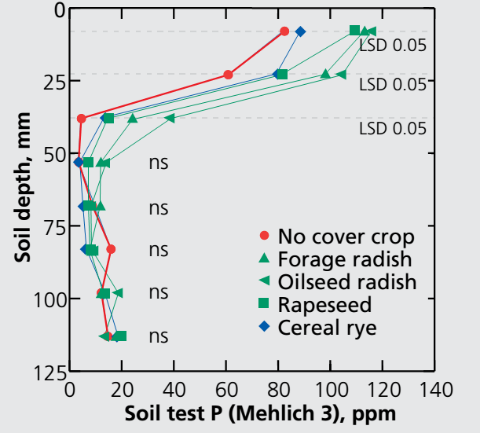
Natural stratification has even been reported, where cover crops recycle sub-soil P to the top soil (Figure. Results from Weil and Graduate Students, in Grove et al., http://agronomypro.com/Nutrient-Stratification-No-till-Soils.pdf ).
How would one-time tillage affect weed control? Conventional tillage buries weeds below depths of emergence; but introduction of tillage in a long-term NT plot also breaks seed dormancy, and can move buried viable weed seeds to the soil surface.
Should I band or broadcast fertilizer under no-till?
Applying P fertilizer by broadcast is easier but the practice is a cause for P stratification. Banding near the seed can reduce fixation and increase uptake early in the season. Deep banding of P reduces stratification near soil surface. Soil sampling in NT following years of fertilizer banding would require more soil samples per field for analysis to better represent the entire field.
Application of starter P or deep banding favors better yields for corn. The 2x2 banding with starter P for corn and broadcast P for soybeans are encouraged in ND. Meanwhile, banding P and K is more critical for small grains since they have limited rooting systems and therefore less capacity to explore large soil volumes. In addition, with shorter growth cycles that begin in early spring with cooler temperatures, banding near the seed can reduce P fixation and enhance uptake with the result of about 10% yield increase in wheat.
Single tillage every other decade or so may not provide any long-term economic benefits in view of the N credits and savings when calculating N fertilizer rates in under long-term no till.
Jasper M. Teboh
Soil Scientist
Moldy Cattle Feed
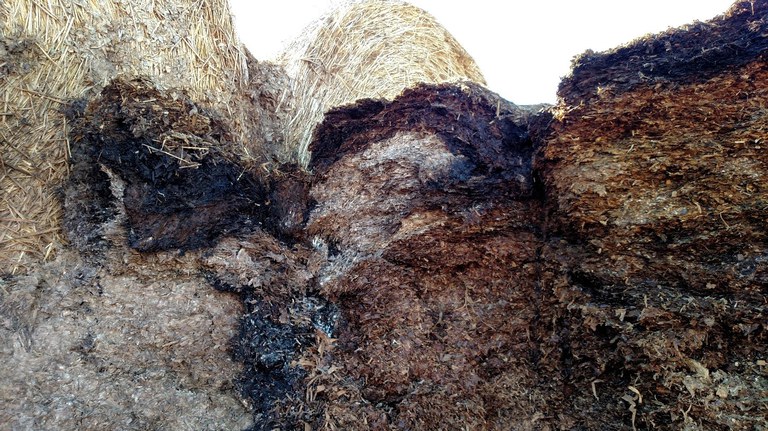
Concerns about moldy feeds seem to increase during winter feeding. Moldy feeds are usually a result of harvesting or baling at too high of moisture content. Or in the case of silage, not high enough moisture content to allow for proper fermentation and acid production. Rain and snow can accumulate on feed to create an environment for molds to grow. However, cool temperatures in winter can reduce mold growth.
Grinding hay during winter can result in a hay pile that heats and becomes moldy. Actually, the snow, ice, and rain moisture on the hay bale mixes during grinding. The moistened hay is a great environment for mold growth. When molds grow, heat is produced and eventually feed quality is lost.
A recent feed analysis of a heated hay pile found the total digestible nutrients (TDN) value at 32% dry matter basis. TDN is a measure of feed energy. Normally this hay would have been 52% TDN. Heating resulted in a 40% loss of energy available for the cow.
Cows will readily consume this dark brown colored feed, but don’t be misled. A large portion of the energy in the feed has been lost.
Feed quality can also be judged by the amount of mold on the feed. Mold counts are done by counting colony forming units (CFUs). As mold concentration increases, cattle may decrease feed intake. Feed energy and protein may also decrease with increasing mold counts. Species of mold can also be determined. Certain species are prone to produce toxins.
Be aware of possible mycotoxins present in moldy feeds. Some mycotoxins, like DON or vomitoxin, have practically no feeding issues in beef cattle diets. Other mycotoxins can be very toxic and cause liver damage, abortion, and death.
The NDSU Veterinary Diagnostic lab can analyze for mycotoxin content. http://www.vdl.ndsu.edu/tests
The Mycotoxin LC/MS/MS screen for 12 more common mycotoxins is $158 per sample ($150 plus $8 accession fee).
That same moldy ground hay sample that lost energy content also contained a mycotoxin at extremely low levels:
Be careful in feeding moldy feeds. Testing for feed quality and presence of toxins may be less expensive than the cost of a sick or dead animal.
Karl Hoppe
Area Extension Livestock Specialist
Corn Plant Population and Relative Maturity
Variety selection is still possibly the most important management decision for your corn crop. Every year we evaluate well over a hundred corn varieties that range from 75-100 relative maturity (RM). Even in lower yielding years, there can be as much as 70 bu/a separating the highest and lowest yielding varieties in our trials. The question becomes, “which one do I chose for my farm/field”. There are many different ways to approach that question, and many different ways to answer it.
One of the first factors that people tend to use is RM. The theory is that the higher the maturity, the higher the yield potential. To see if this is true, we took 4 years of data from our corn variety trials (2012-2015), with 5 trials in each year, and compared the final yield with the maturity of the hybrid. The results varied by environment. At our Fingal location, we didn’t see any relationship between RM and yield. The strongest relationship was at Carrington, where we were able to determine that RM accounted for approximately 25% of the yield difference between hybrids. Even though that sounds low, you could think of it like this; if you had one hybrid yield 140 bushels, and another hybrid yield 160 bushels (a difference of 20 bushels), then RM would account for 5 bushels of that difference, while all other factors including trait package, drought resistance, aggressive vs passive variety, soil-type adaption, and others account for the other 75% difference.
Another way to look at that information is to look at the likelihood that each variety performed above average. Table 1 includes a breakdown of the percent of varieties that performed above average in Carrington at each RM. According to this, from 2012-2015, the RM that gave the best chance of success was a 90 day hybrid. Of course, harvest moisture starts to creep up at about an RM of 89. The bottom line is that RM is only part of the story, good hybrids can still be found at lower RM, and bad hybrids can be found at high RM.
Table 1. The odds of a particular relative maturity (RM) in corn yielding above the average for the trial and the moisture at harvest.
We also have ongoing work with corn plant populations. Table 2 is a summary of the yield results from 2012-2014. This a compiled data set from a range of varieties each year. The maximum yield is achieved at 36000 established plants per acre. However, there is no statistical difference between any populations between 28000 and 40000 plants per acre, and only 6 bu/a separating those values total. So, the optimum plant population during this timeframe occurred right around 28000 plants/a.
Table 2. Comparison of corn yields at each plant population, averaged across 3 years and 4 hybrids (RM 83-RM 90) each year.
Mike Ostlie
Research Agronomist
Haskap Planting Depth Trial Results
In 2011, we established a small planting depth trial to determine optimum conditions for establishing the new haskap fruit crop developed by the University of Saskatchewan – Saskatoon fruit program www.fruit.usask.ca . Haskaps from the breeding program were first released to the public in 2007.
The planting trial is small. It includes eight plants each of ‘Tundra’ and ‘Borealis’. In 2011, half of each of these (4 plants) were planted 1-inch deeper than the nursery plant and half were planted 3-inches deeper. The following spring, half of the plants were pruned to several buds to promote branching. In the following years, plants were pruned with standard practices.
The first fruit from this trial was harvested in 2014 under good fruiting conditions. 2015 fruit developed after poor pollinating conditions and the crop was small. The conclusions were the same in 2014 as were observed in 2015. Results for ‘Borealis’ and ‘Tundra’ were as follows:
- ‘Borealis’ had less fruit if it was pruned and less fruit when planted 1-inch deep.
- ‘Tundra’ had less fruit if it was not pruned and less fruit when planted 3-inches deep.
Assumptions from Haskap Planting Depth Trial of ‘Borealis’ and ‘Tundra’:
- ‘Borealis’ is a naturally well-branched plant. Pruning delayed its branching pattern.
- ‘Borealis’ prefers to be planted deeper.
- ‘Tundra’ is a rangy, thin plant when young. Pruning will increase its branching habit.
- ‘Tundra’ prefers to be planted less deeply.
In the future, I would:
- Plant ‘Borealis’ (2”pots) 3-inches deeper than it was situated at the nursery and I would not prune it back severely the next spring.
- Plant ‘Tundra’ (2”pots) 1-inch deeper than it was situated at the nursery and I would prune it back to several buds to increase branching in the future.
The University of Saskatchewan continues to make thousands of haskap crosses each year. Four varieties have been released since this original breeding and dozens more come into the US from Europe and Japan. Dr. Maxine Thompson, of Oregon, has given rights for a few plants to several propagation companies in the US, as well. Look for the Proven Winners varieties named ‘Solo’ and ‘Maxi’ as well as others to come.
The message to take away is that haskap and honeyberry production knowledge is in its infancy, especially here in the US. I hope that commercial growers in Canada are doing a bit of experimenting as they go along.
Fruit Project Manager
Winter Rye Research at the CREC - Using winter rye as a forage crop
The winter rye focus at the CREC is quite broad ranging from small plot research related to grain, forage, cover crop, weed control, and variety development to field scale seed and forage production. Winter rye has been evaluated as forage crop at the CREC demonstrating its value as a reliable forage crop that provides cover and can extend the haying/grazing season. The use of winter rye as forage is a method of integrating cropland into a livestock system. In harsher northern climates like North Dakota, fall grazing of winter rye is limited although spring grazing is a possibility as rye is one of the first plants to initiate growth and accumulate biomass in the spring. Therefore advantages of using winter rye as a forage crop include the early spring growth along with an associated early harvest, providing an opportunity to sown a second crop for haying, grazing or cover cropping if adequate moisture and fertility levels are present. Average harvest dates of winter rye as a forage crop compared to other winter forages are presented in table 1. Average harvest date (10 year) compared to the past two growing seasons are presented illustrating differences within years.
Spring stand data (not shown here) illustrates that rye is the most winter hardy compared to the other winter cereals. Average harvest dates (table 1.) gathered over the years show the differences among the crop types in maturity. Forage treatment harvest dates were determined by the growth stage of the forage each year. Rye was harvested first, followed by triticale, wheat and then spelt. Harvest stage for all treatments was early to mid-anthesis or 5-10 days after heading depending on forage species. Results (table 2.) illustrate the relative yield differences among the winter cereal types trialed. Forage yields for winter rye, 2.5 ton/ac DM, are similar to winter wheat and triticale during the years of these trials. Forage yield of winter spelt is greater than the other winter cereals compared. This yield difference may in part be due to the later maturity of spelt. Rye tends to be lower in quality when compared to wheat or other crops used. Although significant quality differences exist they are minor comparing the crops. Winter wheat has the highest crude protein and TDN along with the lowest fiber values. Average protein for rye has been 11.5% with a TDN of 54. Relative Feed Value (RFV) which use multiple parameters to measure the forage quality show rye to be at 97.
Table 2. Forage yields, tons/ac DM
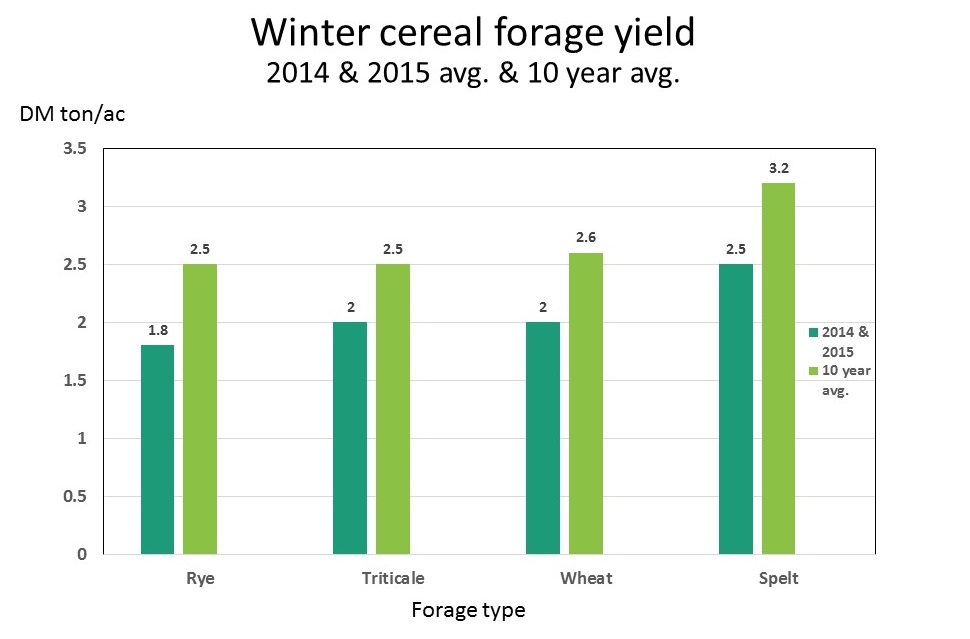
Steve Zwinger
Agronomy Research Specialist
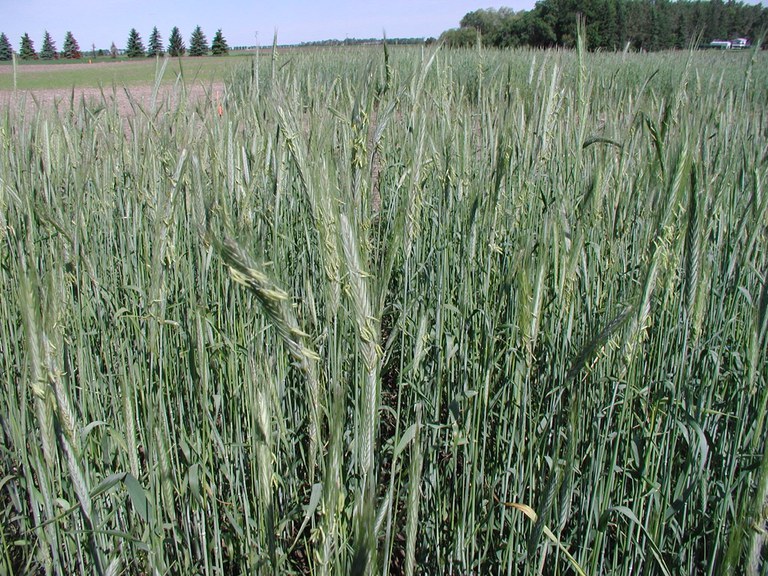
Winter rye at anthesis on June 7, 2010 at the CREC.
Strategies for Profitable Soybean Production
NDSU Extension Service projected crop budgets are indicating challenges in generating a positive return to labor and management with soybean in 2016. With conservative market price projections and difficulty in reducing costs, the best method for making money with soybean is increasing yield. A basic strategy: 1) start with high yield potential - variety selection, and adequate plant establishment and nutrition; and 2) plant protection – manage weeds, disease and insects.
Main factors in variety selection include yield, maturity, herbicide tolerance traits, disease resistance, soybean cyst nematode resistance, iron chlorosis tolerance and market opportunities. NDSU Extension Service soybean variety references include ‘ND Soybean Variety Trial Results for 2015 and Selection Guide’ (www.ag.ndsu.edu/pubs/plantsci/rowcrops/a843_15.pdf).
The following is the current (January 2016) listing of yield comparisons by percentage for selected soybean plant establishment factors based on NDSU trials conducted during 1999-2015 (the italicized factor is recommended versus the alternative factor):
- Yield with reduced-till systems (no-till, strip till and direct seeded) was 4% > conventional tillage.
- Soybean following wheat yielded 5% > soybean as prior crop.
- Early planted soybean (last week in April through first week in May) yield was 9% > mid-May planted soybean.
- Planting rates of 150,000 to 175,000 pure live seeds (pls)/acre yielded 6% > planting rates of 100,000 to 130,000 pls/acre.
- Yield with intermediate row spacing (14 to 21 inches) was 3% > wide rows (28 to 30 inches).
- Use of fungicide-treated seed provided yield 6% > untreated seed.
- Weed control starting at planting time provided yield 5% > post-emergence weed control initiated when weeds were 2- to 4-inches tall.
General soybean plant nutrition recommendations:
- Do not apply fertilizer nitrogen. Use bacterial seed inoculant on fields without prior soybean history and consider as normal practice on all soybean fields.
- Apply phosphorus and potassium on soils with test levels less than medium.
- Yield response unlikely with other secondary or micro nutrients.
For details see NDSU Extension Service circular ‘Soybean Soil Fertility’ (www.ag.ndsu.edu/pubs/plantsci/soilfert/sf1164.pdf).
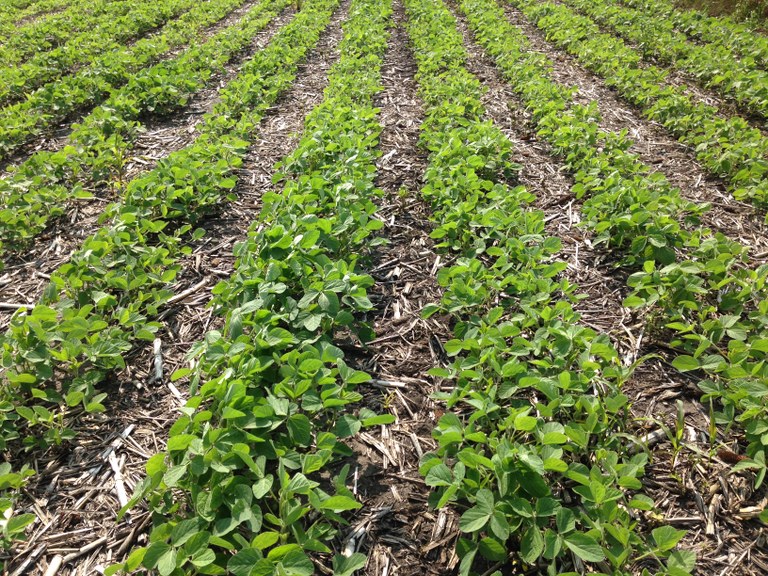
2016 NDSU Extension Service circulars available for managing weeds, disease and insects: Weed Control Guide (www.ag.ndsu.edu/weeds/weed-control-guides), Field Crop Plant Disease Management Guide, and Field Crop Insect Management Guide (www.ag.ndsu.edu/publications/landing-pages/crops/field-crop-insect-management-guide-e-1143). An NDSU app also is available for managing all three pest areas: www.ag.ndsu.edu/crops.
Greg Endres
Area Extension Agronomist
Adjusting Cattle Rations During [Extreme] Cold Weather
The weekend of Jan 16-17, 2016 contained wind chill temps of -44 and -40 degrees Fahrenheit (F). For the USDA Livestock Indemnity Program, extreme cold is defined by wind chill at or colder than -40 degrees F for adult cattle and -20 degrees F for calves.
If you have livestock losses due to extreme cold, you will need to report the loss to the FSA office within 30 days of the loss to qualify for an LIP payment.

While exposure to extreme cold is dangerous and life threatening, producers do try to mitigate the exposure to extreme cold by providing bedding, windbreaks or wind protection, external parasite control, and adequate feed.
Research at the CREC by Dr. Vern Anderson found bedding and generous bedding (double bedding) improved feed conversion and improved carcass quality of feedlot cattle. Five to seven pounds of straw was used per head daily for bedding.
Cattle are acutely aware of wind chill and will seek protection from the wind. Cows will use whatever is available, including a hay feeder or another cow. Lice control will prevent cattle from rubbing their warm hair off.
Cattle do adapt to cold weather by growing a thick hair coat. This hair coat can be over a half inch deep and provides protection as long as the hair coat is dry. Wet hair loses its ability to insulate.
Due to this thick winter coat, cattle are comfortable down to 18 degrees F according to the National Research Council’s Effects of Environment on Nutrient Requirements of Domestic Animals. When the temperature is lower than the cattle’s lower critical temperature (18 degrees), cattle require 2% more energy per degree Celsius. Or roughly, for every 10 degree drop in temperature, cattle need 10% more energy.
Cattle will typically increase their feed intake with colder weather. Simply providing more feed during these short term temperature drops will meet the cow’s nutritional needs.
However, long term cold weather exposure will cause an increase in energy needed by the cow will require a more energy dense ration (provide grain and/or better quality hay). If the cow doesn’t get fed well, she will metabolize body fat to stay warm and consequently lose weight. When a pregnant cow loses weight during the last three months of pregnancy, it more often leads to calving difficulties and rebreeding problems.
Karl Hoppe
Area Extension Livestock Specialist
Evaluation of implanting suckling steer calves in a dry-lot management system

The performance benefits of implanting calves during the suckling phase is well documented. Although many cattlemen do not take advantage of this tool. The reasons for this vary, but one that pops up frequently is the thought that implanting nursing calves decreases calf performance post weaning. Additionally the body of research on this topic is designed around cows and calves that are on pasture at the time the suckling implant is employed.
The Carrington Research Extension Center has been conducting research evaluating alternative cow management systems with cows and calves managed year round in dry-lot pens with daily feed delivery to a bunk. In this system, in addition to suckling, calves are provided with a creep ration in a bunk that excludes cow accesses.
In 2015 we designed a trial to evaluate the effects on weaning weight, average daily gain and post weaning performance of suckling steers implanted and managed in the dry-lot system. We randomly allotted dry-lot managed steer calves (n= 49 head) to one of two treatments: 1) control: no implant or 2) implanted with Ralgro® (36 mg Zeranol). Calves were weighed and allotted to treatment on May 15, 2015 and averaged 225 pounds (Table 1). The implanted steers gained 0.14 pounds/head/day (lb/hd/d) more than their non-implanted contemporaries and thus were 30 lbs heavier at weaning.
At weaning all steers were moved to the weaning pen at the center and started on a weaning/growing ration. Twenty-eight days after weaning all calves were weighed and implanted or re-implanted. The first month post weaning, the steer calves that were implanted during the suckling phase gained slightly more (2.22 lb/hd/d) than the non-implanted steers (2.18 lb/hd/d). Interestingly following re-implant, from day 28 post weaning, the calves that were implanted during the suckling phase seemed to respond greater than the control steers that were implanted for the first time (Table 2).
In conclusion implanting nursing calves increased weaning weights. Additionally steers that were given an implant during suckling gained more weight post weaning and seemed to respond greater to the initial post weaning implant than the control steers.
Chanda Engel
Research Specialist
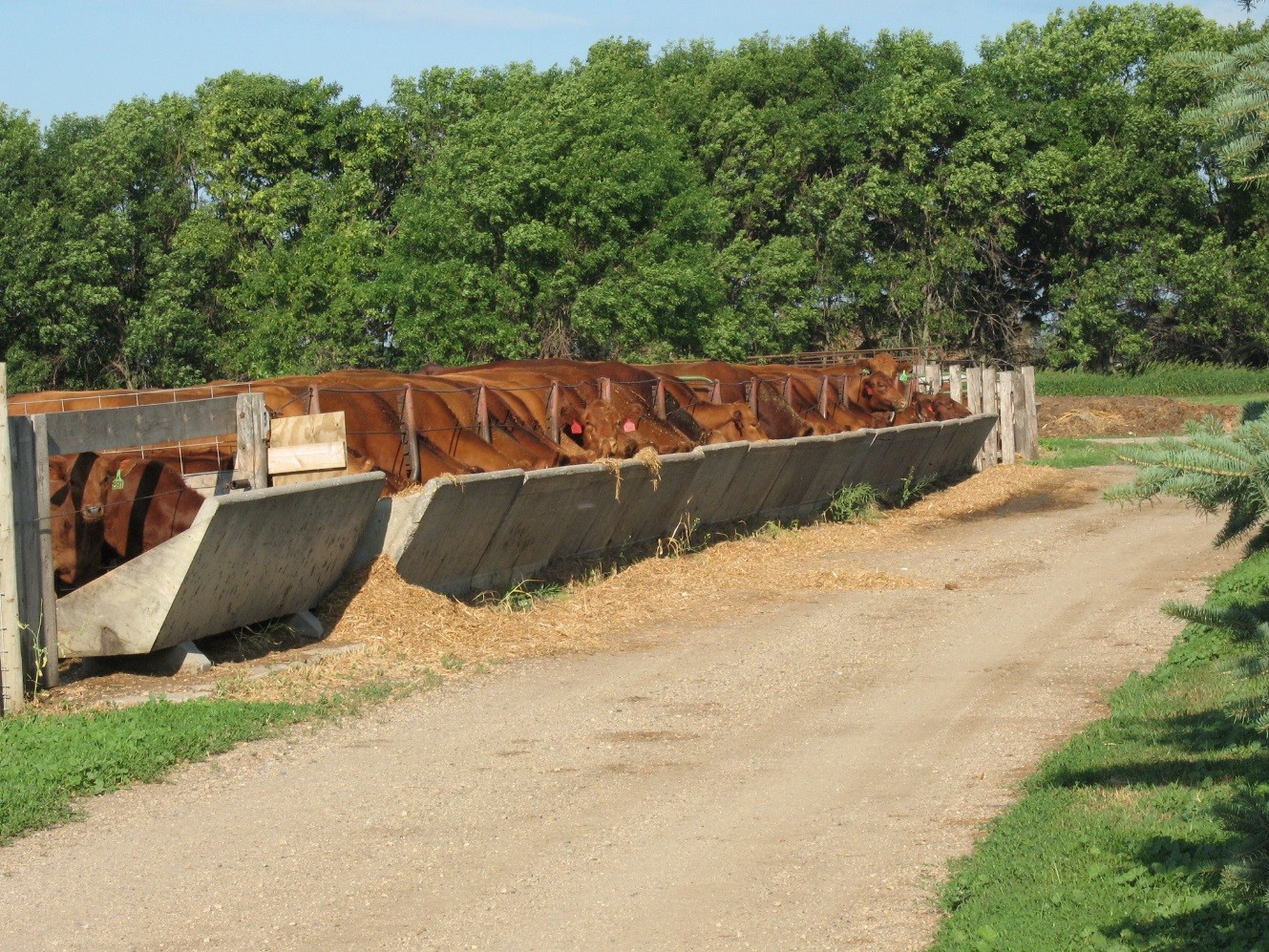
Advanced Crop Advisers Workshop Set for Feb. 9-10 in Fargo
The Advanced Crop Advisers Workshop is scheduled for Tuesday and Wednesday, February 9-10, at the Holiday Inn in Fargo. The workshop is designed to provide in-depth discussion of selected topics for agricultural professionals to enhance their crop production recommendations for farmers. The event is organized and conducted by the North Dakota State University Extension Service and University of Minnesota Extension.
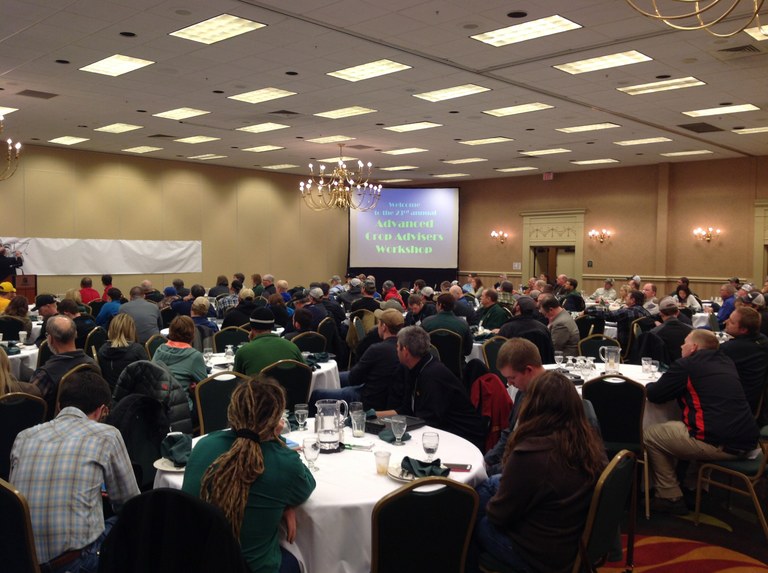
February 9 educational sessions are:
- Alternate crop disease management
- Microorganisms and cover crops: What positive things can we see?
- What’s emerging with corn stands?
- A fusion of insect and disease topics
- Utilizing Iowa experience to assist us with managing herbicide-resistant weeds
Also, the presentation ‘African and Asian small-scale farming: What can we learn?’ will be given during lunch.
Feb. 10 educational sessions are:
- Current and future farm financial challenges
- What’s your plan to control herbicide-resistant weeds?
- The developing water issues facing agriculture
- Split N application for corn and wheat: Where, when, how and what to expect
Preregistration is required. The workshop fee is $140 if received by Feb. 5 or $75 if attending one day. Late registration fees are $175 or $100 for one day. The fee includes three meals and refreshment breaks, and reference materials.
Certified crop advisers will have the opportunity to receive 11 continuing education units.
A brochure that contains workshop details, including a preregistration form, is at www.ag.ndsu.edu/CarringtonREC/. Electronic preregistration and credit card payment can be made at http://tinyurl.com/CRECstore.
For further information, contact Greg Endres at the NDSU Carrington Research Extension Center at (701) 652-2951 or Phillip Glogoza, Minnesota Extension in Moorhead, at (218) 236-2008.
Greg Endres
Area Extension Agronomist
New Animal Scientist!
Howdy! My name is Uchenna Anele and I’m the “new guy” in town. I am excited to join the Carrington Research Extension Center as the Animal Scientist. I grew up in Enugu in southeastern Nigeria. I trained in animal sciences in Nigeria earning B.S. and M.S. degrees in Agriculture (animal science major) and Pasture and Range Management, respectively. My Ph.D. was in forage utilization and ruminant nutrition from the University of Bonn, Germany.
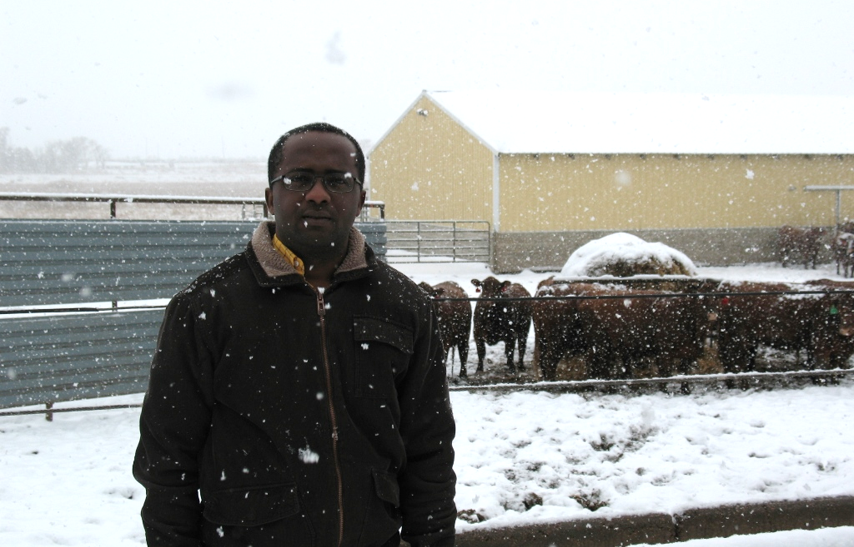
Before joining the NDSU CREC, I was a lecturer in the Department of Pasture and Range Management, Federal University of Agriculture, Abeokuta; a postdoctoral research associate at Texas Tech University and a visiting research fellow at Lethbridge Research Center, Agriculture and Agri-Food Canada.
I have done lots of studies including integrated crop/livestock farming systems, forage utilization, ruminant nutrition, greenhouse gas abatement, and evaluation of non-conventional feedstuffs.
Moving forward, I will continue the drylot cow/calf system that the CREC is known for. I will focus on high priority needs of producers in the state. I will also undertake studies like the use of exogenous enzymes to improve fiber digestion of several co-products and crop residues generated in North Dakota; use of pre- and probiotics in the feedlot; and integrated crop/livestock approach to address high salinity soil issues in North Dakota.
I look forward to meeting you in the nearest future. Feel free to drop me an email (uchenna.anele@ndsu.edu) or give me a call (701-652-2951) anytime.
Uche Anele
Animal Scientist


